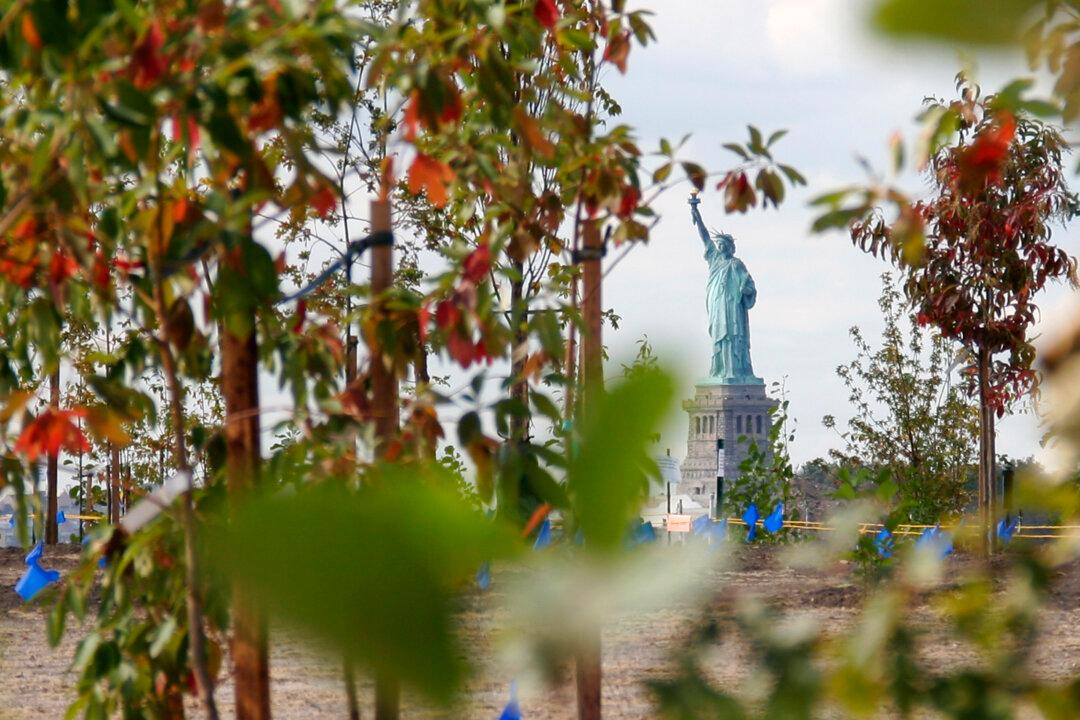NEW YORK—Rows of hundreds of sapling trees are curving across the sloped hills on Governors Island where a flat, 2,200-car-space parking lot once was.
The parking lot was torn up and the buildings around it were torn down one by one, culminating in an implosion of an 11-story non-historic building, the largest on the island. As the dust cloud settled, the Statue of Liberty came into full view.
On Sept. 29, people poured in from the ferries on the last day of the park’s open season. They walked along the curved and sloping paths at the newest, unfinished, though already spectacular part on the island. The park’s topography was elevated using the very debris from the demolished buildings and parking lot.
Officials opened up the Liggett Terrace and Hammock Grove areas of the future park to preview the trees, flowers, hammocks, play areas, hedge gardens, and ball fields that will be finished by the time the island reopens next year.
The southwest portion of the island, on which the new park is situated, was created using millions of cubic yards of landfill from the Lexington Avenue subway in 1912. For decades, it lay as a flat and daunting landscape covered by a massive parking lot and gray buildings. Amsterdam-based landscape and architecture firm West 8 won a design contest to transform the area.
The core of West 8’s proposal was to change the topography of the land by gently elevating and curving the walkways and planted areas to create the effect of paths disappearing beyond the line of sight. The resulting landscape tugs at visitors’ curiosity, beckoning them to keep exploring.
The topography is functional as well: the elevated areas provide shelter for vehicles and equipment in case of a flood. At the same time, the hills give the root systems of the trees protection from the salt water that exists at lower elevations. Resilience was built into the plan for Governors Island even before Hurricane Sandy. The island lost only eight trees during the storm.
The entryway to the new park is through the Arch underneath the Liggett Hall, a former military barracks. As visitors emerge from the Arch, they walk into the Liggett Terrace. To the left and right lie manicured hedge gardens accented by petal-shaped flower groves. The flowers were hand-selected to bloom from spring through late fall and are predominantly magenta-colored.
Beyond Liggett Terrace are several paths that elevate into Hammock Grove beyond. Rows of sapling trees stretch between the paths. The trees are planted on a grid designed to reveal the Statue of Liberty beyond. When the planting is completed, some 1,500 trees will grow in the area with 50 hammocks stretched throughout.
“The entire tree system and the grid that is planted here is also designed for the sight lines. As you’re walking up here you can always see views of the harbor,” said Jamie Hand, director of planning and public involvement at the Trust for Governors Island.
The Hammock Grove terminates to a view of what’s yet to come in the years to follow. The remainder of the landfill will be combined with landfill barged in from Buffalo to construct four hills of different heights, each with unique features and character. The Slide Hill, for example, will feature slides for children and families, while the Discovery Hill will feature site-specific art.
Two turf fields for little league baseball and adult softball are nestled amid the hills. The foul balls there will rise and fall to the backdrop of Lady Liberty.
“It’s one of the best baseball field sights in the city,” Hand said. “We’re sort of bracing ourselves for demand once we open next year.”





